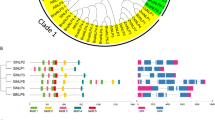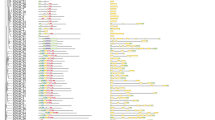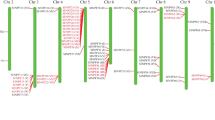Abstract
Ascorbic acid or vitamin C is a wide spectrum antioxidant and plays a crucial role in a many metal-containing enzymes essential for humans, which are unable to synthesize the vitamin C and must obtain it from dietary sources. Ascorbic acid is transported by sodium-coupled ascorbic acid transporters or SVCTs in humans. However, little information is available about the nucleobase–ascorbate transporters (NATs) in tomato (Solanum lycopersicum). In the current study, we identified 12 NAT genes by screening SGN genome databases in tomato. A complete overview of this gene family in tomato is presented, including gene structures, chromosome distribution and localization, phylogenies, motif analysis and expression profiles. The SlNAT genes contained 14 exons, mostly, and dispersed on all the chromosomes except chromosome 8 and 9. All the SlNATs were located to plasma membrane, chloroplast thylakoid membrane, Golgi body, and endoplasmic reticulum (membrane). The phylogenetic tree showed that the plant NATs were divided into 4 clades, well-supported by the distribution of conserved motifs, and the SlNAT proteins shared higher similarity and clustered more closely with AtNAT proteins. Furthermore, the expression profiles of SlNAT genes in various organs showed 9 out of 12 SlNAT genes were constituently expression with differential expression levels under normal growth conditions. Our systematic analysis will provide a useful platform for molecular clone and functional identification of NAT genes in tomato and probably other Solanaceae plants.



Similar content being viewed by others
References
Agius F, Gonzalez-Lamothe R, Caballero JL, Munoz-Blanco J, Botella MA, Valpuesta V (2003) Engineering increased vitamin C levels in plants by overexpression of a d-galacturonic acid reductase. Nat Biotechnol 21(2):177–181
Argyrou E, Sophianopoulou V, Schultes N, Diallinas G (2001) Functional characterization of a maize purine transporter by expression in Aspergillus nidulans. Plant Cell 13(4):953–964
Asard H, Horemans N, Caubergs RJ (1992) Transmembrane electron transport in ascorbate-loaded plasma membrane vesicles from higher plants involves a b-type cytochrome. FEBS Lett 306(2):143–146
Badejo AA, Wada K, Gao Y, Maruta T, Sawa Y, Shigeoka S, Ishikawa T (2012) Translocation and the alternative d-galacturonate pathway contribute to increasing the ascorbate level in ripening tomato fruits together with the d-mannose/l-galactose pathway. J Exp Bot 63(1):229–239
Bailey TL, Elkan C (1994) Fitting a mixture model by expectation maximization to discover motifs in biopolymers. Proc Int Conf Intell Syst Mol Biol 2:28–36
Bartoli CG, Pastori GM, Foyer CH (2010) Ascorbate biosynthesis in mitochondria is linked to the electron transport chain between complex III and IV. Plant Physiol 123:335–343
Burzle M, Suzuki Y, Ackermann D, Miyazaki H, Maeda N, Clemencon B, Burrier R, Hediger MA (2013) The sodium-dependent ascorbic acid transporter family SLC23. Mol Aspects Med 34(2–3):436–454
Corpet F (1988) Multiple sequence alignment with hierarchical clustering. Nucleic Acids Res 16(22):10881–10890
de Koning H, Diallinas G (2000) Nucleobase transporters (review). Mol Membr Biol 17(2):75–94
Franceschi VR, Tarlyn NN (2002) l-Ascorbic acid is accumulated in source leaf phloem and transported to sink tissues in plants. Plant Physiol 130:649–656
Gallie DR (2013) l-ascorbic acid: a multifunctional molecule supporting plant growth and development. Scientifica. doi:10.1155/2013/795964
Horemans N, Potters G, Caubergs R, Asard H (1998) Transport of ascorbate into protoplasts of Nicotiana tabacum Bright Yellow-2 cell line. Protoplasma 205(1):114–121
Horemans N, Foyer CH, Asard H (2000) Transport and action of ascorbate at the plant plasma membrane. Trends Plant Sci 5(6):263–267
Lorence A, Chevone BI, Mendes P, Nessler CL (2004) Myo-inositol oxygenase offers a possible entry point into plant ascorbate biosynthesis. Plant Physiol 134(3):1200–1205
Maurino VG, Grube E, Zielinski J, Schild A, Fischer K, Flugge UI (2006) Identification and expression analysis of twelve members of the nucleobase–ascorbate transporter (NAT) gene family in Arabidopsis thaliana. Plant Cell Physiol 47(10):1381–1393
Meintanis C, Karagouni AD, Diallinas G (2000) Amino acid residues N450 and Q449 are critical for the uptake capacity and specificity of UapA, a prototype of a nucleobase–ascorbate transporter family. Mol Membr Biol 17(1):47–57
Saitou N, Nei M (1987) The neighbor-joining method: a new method for reconstructing phylogenetic trees. Mol Biol Evol 4(4):406–425
Szarka A, Banhegyi G, Asard H (2012) The inter-relationship of ascorbate transport, metabolism and mitochondrial, plastidic respiration. Antioxid Redox Signal. doi:10.1089/ars.2012.5059
Tamura K, Dudley J, Nei M, Kumar S (2007) MEGA4: molecular evolutionary genetics analysis (MEGA) software version 4.0. Mol Biol Evol 24(8):1596–1599
Tedone L, Hancock RD, Alberino S, Haupt S, Viola R (2004) Long-distance transport of l-ascorbic acid in potato. BMC Plant Biol 4:16. doi:10.1186/1471-2229-4-16
Wheeler GL, Jones MA, Smirnoff N (1998) The biosynthetic pathway of vitamin C in higher plants. Nature 393(6683):365–369
Wolucka BA, Van Montagu M (2003) GDP-mannose 3′,5′-epimerase forms GDP-l-gulose, a putative intermediate for the de novo biosynthesis of vitamin C in plants. J Biol Chem 278(48):47483–47490
Xu G, Guo C, Shan H, Kong H (2012) Divergence of duplicate genes in exon-intron structure. Proc Natl Acad Sci USA 109(4):1187–1192
Zechmann B, Stumpe M, Mauch F (2011) Immunocytochemical determination of the subcellular distribution of ascorbate in plants. Planta 233(1):1–12
Acknowledgments
This study was supported by grants from the State Major Basic Research Development Program (No. 2011CB100600), and National Natural Science Foundation of China (No. 31171974).
Author information
Authors and Affiliations
Corresponding author
Electronic supplementary material
Below is the link to the electronic supplementary material.
Rights and permissions
About this article
Cite this article
Cai, X., Ye, J., Hu, T. et al. Genome-wide classification and expression analysis of nucleobase–ascorbate transporter (NAT) gene family in tomato. Plant Growth Regul 73, 19–30 (2014). https://doi.org/10.1007/s10725-013-9864-x
Received:
Accepted:
Published:
Issue Date:
DOI: https://doi.org/10.1007/s10725-013-9864-x




